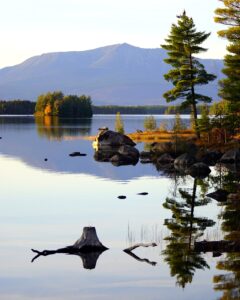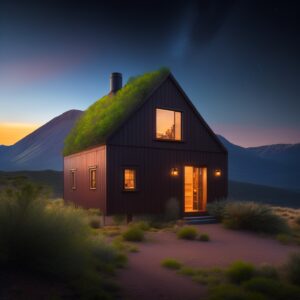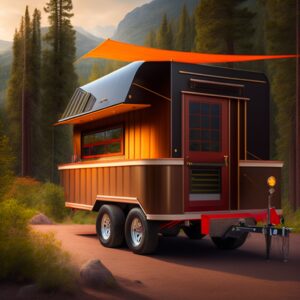Welcome, explorers and trailblazers! Today, we venture into the world of living off the grid communities, a haven of self-sufficiency, sustainability, and serenity. Picture a place where the rat race is replaced by the rustle of leaves, where you sip water from a rain-harvesting system instead of a plastic bottle, and where the electricity bill is as foreign a concept as traffic noise. It’s a return to our roots, a bid to coexist peacefully with nature, and an embodiment of conscious living. If you’re yearning for simplicity, independence, and a deep sense of community, buckle up – you’re in for an enlightening journey.
Picture this:
- The wind rustles the leaves of the trees around you and a brook gurgles nearby.
- The sunlight filters through the canopy overhead.
- The air smells clean and fresh.
You’re in your very own sanctuary, nestled in nature. This is the reality of an untamed life, the serenity of nature, the satisfaction of self-sustainability. Intrigued? Well, sit tight; we’re just getting started.
Understanding the Concept of Living Off the Grid
Living off the grid communities – it sounds like a term ripped out of a dystopian novel, doesn’t it? Yet, it’s a reality for millions across the globe. Imagine a life without monthly utility bills, constant traffic, or the hustle and bustle of urban life. A life that’s self-sustained, environmentally friendly, and deeply fulfilling. That’s the essence of living off the grid, whether it be in self sustaining homes or off grid trailers. It’s about withdrawing from public utilities to exist independently, relying on nature and your own resources. It’s about living a life that’s free, literally and metaphorically. It’s like rebooting your life in ‘safe mode.’
The Origin and Evolution of Off the Grid Living
Living off the grid might sound like a concept born from the countercultural movements of the 1960s and 70s, but the truth is it has been around since humans first walked the Earth. Our ancestors lived a life that was entirely off the grid, living with the land, embracing sustainable agriculture, and taking what was needed from the natural world. The concept of a grid, be it electricity, water, or otherwise, was not even a blip on the horizon.
The first instances of intentional off-grid living in recent times can be traced back to pioneers such as Thoreau, who, in the 1850s, chose to live simply in nature. His experiment in self-reliance at Walden Pond set a precedent for those who wished to break free from societal norms and embrace a different kind of existence.
Fast forward to the 20th century, building off the grid started making a comeback in the 1970s with the back-to-the-land movement. People disillusioned with the consumerist culture started moving to rural areas to establish self-sufficient, agrarian communities. The movement was a response to various social and political factors of the time, including the Vietnam War, the civil rights movement, and environmentalism.
Today, off-grid living has evolved into a movement that’s gaining momentum around the globe. With the growing awareness of climate change and environmental degradation, more and more people are drawn to living sustainably and reducing their dependence on finite resources.
Where are Off the Grid Communities Most Prevalent?
Living off the grid communities have sprung up in nearly every corner of the globe, from the United States to Europe, from Australia to South America. You can probably identify them from the telltale plethora of wind turbines! However, certain countries and regions stand out for their prevalence of off-grid living.
In the United States, states like Alaska, Maine, Vermont, and Missouri have many off-grid households thanks to favorable geography and regulations. Europe, too, is home to many off-grid communities.
Australia is another country where off-grid living is gaining popularity, driven by the country’s ample sunshine for solar power and vast areas of uninhabited land. Like the Crystal Waters community in Queensland, Eco-villages are pioneering sustainable living down under.
Exploring the Reasons to Live Off the Grid
Why do people choose to live off the grid? The reasons are as diverse as the individuals themselves. Some seek to reduce their carbon footprint, while others cherish the peace and quiet. Some are drawn to self-sufficiency, and others are guided by economic reasons. The beauty is that there’s no right or wrong reason – if you hear the call of the wild, you answer it. It’s an act of rebellion against conformity and embracing the extraordinary.
The Financial Implications of Living Off the Grid
Living off the grid isn’t about abandoning all worldly possessions and becoming a hermit. It’s a financial decision too. Sure, the initial investment might make your wallet a bit lighter. But once you’re past the setup stage – building a house, setting up renewable energy sources, etc. – the cost of living drops significantly. No electricity or water bills and lower grocery bills – sounds like a sweet deal.
Key Features of Off the Grid Communities
Living off the grid isn’t just about moving into the woods with a tent and a backpack. It’s about building a community that shares resources, responsibilities, and experiences. A place where people come together to live consciously and conscientiously.
Self-Sufficiency: The Pillar of Off the Grid Living
Self-sufficiency is the lifeblood of off-grid living. It’s about producing what you consume, be it food, power, or goods. Think solar panels, wind turbines, rainwater harvesting, organic farming, recycling, and upcycling. It’s a beautiful cycle of create-consume-recycle, all done in-house. It’s like the circle of life, only the circle of sustainable life.
Community Engagement: A Vital Aspect of Off the Grid Life
Community engagement is what sets off-grid living apart from merely living in isolation. In these communities, everyone contributes to everyone else’s well-being. Shared kitchens, cooperative farming, skill swaps, and communal decision-making create a bond beyond the typical neighborly relationship. It’s a profound sense of connection that our hyper-connected world ironically often lacks.
Infrastructure and Resource Management in Off the Grid Communities
The success of an off-grid community hinges on its infrastructure and resource management, from building houses with local, sustainable materials, and managing waste responsibly, to sharing resources like tools, vehicles, and even Wi-Fi – every aspect is thoughtfully planned. It’s like a game of Tetris, where every piece has its place and role in creating the perfect balance.
A Deep Dive into Notable Off the Grid Communities Worldwide
Dancing Rabbit Ecovillage: Sustainability in Action
Dancing Rabbit Ecovillage in Missouri isn’t just a community; it’s a commitment to a way of life that harmonizes with nature. The homes are made from straw bales and cob, powered by the wind and sun, and water comes from rainwater harvesting and a community well. With shared meals, community governance, and cooperative businesses, it’s a vibrant experiment in sustainability and community living.
Earthship Biotecture: Living with Zero Waste
Have you ever heard of a home that heats and cools itself naturally, generates electricity, collects water, treats sewage, and produces food? Well, welcome to Earthship Biotecture in New Mexico! These homes, made from recycled materials, are a testament to the possibility of a life with zero waste. This community is a living, breathing example of sustainable design and construction.
Greater World Community: Harnessing the Power of the Sun
Welcome to the world’s first Earthship subdivision, the Greater World Community in New Mexico. This 634-acre plot of land is home to residents who’ve said a big ‘yes’ to sustainable living. With homes that are 100% off-grid, water harvesting four times the local annual rainfall, and electricity powered entirely by the sun and wind, this community is a beacon of sustainable living.
Findhorn Ecovillage: Balancing Spiritual and Sustainable Living
Located in the north of Scotland, Findhorn Ecovillage is not just an off-grid community but a spiritual community too. With sustainable buildings, ecological wastewater treatment, and a wind park, the community balances sustainability and spirituality. It’s proof that living off the grid can be a journey for the body, mind, and spirit.
Making the Leap: How to Transition to Off the Grid Living
Convinced yet? If the call of the wild resonates with your spirit, it’s time to start planning your transition.
Assessing Your Needs and Capabilities
Transitioning to off-grid living is a process; the first step is understanding what you need. Are you ready to give up your daily Starbucks for a cup of homemade herbal tea? Are you okay with composting toilets? Can you live without 24×7 internet? These are the questions you need to ask yourself. Remember, this is about building a life that aligns with your values, not punishing yourself!
Planning and Preparation: Building Your Off the Grid Dream
Once you’ve assessed your needs, it’s time for planning and preparation. This is where you figure out the nitty-gritty details: Where will you live? How will you source water and electricity? How will you manage waste? What kind of house will you build? It’s a big project, but the payoff is equally significant.
Adapting to Off Grid Life: It’s a Journey, Not a Destination
The final step of transitioning is adjusting. And this is a continuous process. Every day, you’ll learn something new, face a new challenge, and discover a new joy. And in that process, you’ll grow and evolve, just like the environment around you.
Conclusion
Off-grid living is a path to a more sustainable, interconnected, and fulfilling life. It’s not just about disconnecting from the grid but about reconnecting with nature, people, and, most importantly, yourself. It’s a lifestyle of freedom, self-sufficiency, and sustainability. So, are you ready to take the leap?
FAQs
-
How does living off the grid affect your social life?
While it might seem that living off the grid could isolate you, it might actually have the opposite effect. Off-grid communities often have a strong sense of camaraderie and interdependence. People rely on each other for help, support, and company. This could mean potluck dinners, community workdays, shared childcare, and many other communal activities that foster a deep sense of connection.
-
Is living off the grid legal?
In most places, yes, living off the grid is legal, but there can be restrictions and regulations that need to be considered. Some areas have laws regarding septic systems and access to public utilities, while others may have restrictions on collecting rainwater. It’s important to thoroughly research and understand the laws and regulations in your desired area before making the move.
-
Can families with children participate in living off the grid communities?
Definitely! Many off-grid communities are home to families with children. These communities can be incredibly nurturing environments for kids, offering a close-knit community, plenty of outdoor space for play and exploration, and hands-on learning opportunities. However, it’s important for families to consider educational arrangements and access to healthcare facilities.
-
Do you need to be physically fit to live off the grid?
While physical fitness can certainly help with the demands of off-grid living such as gardening, building, and other manual work, it’s not a strict requirement. Many off-grid communities have a range of residents of varying age and ability, and tasks are often shared according to capability.
-
What happens if I get sick while living off the grid?
Most off-grid communities have plans in place for medical emergencies. This might involve having trained first aiders in the community, designated drivers for hospital trips, or telemedicine options for remote consultation. Nonetheless, it’s essential to have a personal plan, including knowing the location of the nearest medical facility and maintaining a well-stocked first aid kit.





Pingback: Solar Water Pump: Sustainable Water Solutions - Eco Life Wise
Pingback: How to Live Off the Grid: Your Ultimate Guide
Pingback: Goodwill Recycling: Transforming Lives and Our Planet
Pingback: Navigating the World of Sustainable Clothing Brands
Pingback: What Is Sustainability? Unlocking the Power to Transform Our World
Pingback: Off Grid Air Conditioner: A Green Solution to Beat the Heat
Pingback: Why are Natural Resources Important? Discover Earth's Treasures
Pingback: Best Organic Coffee Brands: Your Ultimate Coffee Experience | Eco Life Wise
Pingback: What Is The Impact Of Deforestation On Our Climate? 10 Points to Ponder | Eco Life Wise
Pingback: How Do Oil Spills Affect Marine Life? | Eco Life Wise
Pingback: What Is The Importance Of Wetlands? 10 Significant Factors | Eco Life Wise
Pingback: Is Cardboard Recyclable? You Might Be Surprised | Eco Life Wise
Pingback: Building Off the Grid: A Guide to a Self-Sustained Lifestyle
Pingback: TPS Power Sports Portable Toilet Review | Eco Life Wise